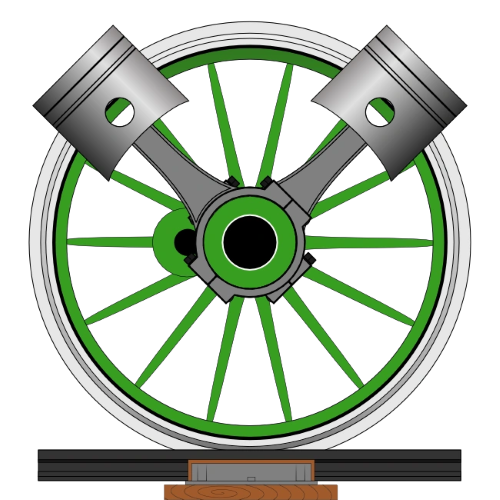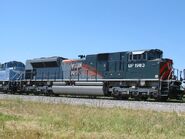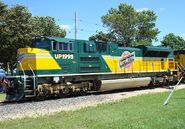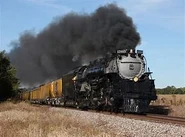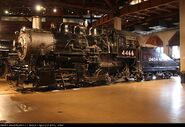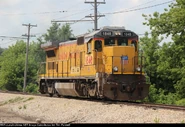The Union Pacific Railroad (UP, UPRR) is a standard-gauge US Class 1 (or major) freight railroad in the United States and is the largest and oldest currently operating railroad in both the United States and the world, which also serves as the main freight railroad in the United States as well as also being considered to be the very last of the original US Class 1 railroads (not including its lesser-known counter-part or predecessor). The railroad was also originally both a freight and passenger railroad at one time, yet passenger operations ceased in 1971 due to the formation of Amtrak.
The railroad itself, also has the largest fleet of locomotives, one of the only steam locomotives to never be retired in the US (aside from being one of the only American-based railroads to not fully retire steam), and have the largest railyard in the world. They've even
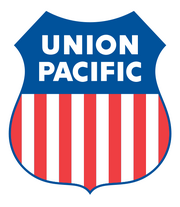
The official Union Pacific logo. Which was first introduced during the 1930s.
owned some of the largest locomotives ever built as well.
Their headquarters have changed several times, but is now currently headquartered in Omaha, Nebraska, which is near North Platte; home of Bailey Yard (named after former UP president); the largest railyard in the world, which is actually a combination of 5 or 6 different classification yards.
Their arch-rival is BNSF Railway, which covers most of the same trackage.
2012 marked the official 150th anniversary of the railroad.
Early History
The railroad was first officially established in 1862 as the Pacific Railway (chartered by the Pacific Railway Act signed by president Abraham Lincoln) which was once one of the smallest US Class 1 railroads, though the railroad began to connect with the Central Pacific from 1861 (before becoming the Southern Pacific) to May 10, 1869 at Promontory, Utah, forming the first transcontental rail line. The actual Union Pacific name for the railroad was established during the events of the ceremony, but wasn't officially chartered until 1880; to whom it was established after what was left of the original Pacific Railway, yet it wasn't so small after the first ever transcontinental railroad line was built in the United States, connecting the Central Pacific (which eventually became the Southern Pacific; as mentioned above) and the Union Pacific across the Western States or West Coast in the US with half of the East Coast. The Pacific Railway was established sometime during the 1860 to 1861 (shorty before the Civil War began the following months during 1861, but during the events revolving around it) under the "Pacific Railway Act" documented by former U.S President Abraham Lincoln. Little is known about the railroad's early history, other than the historical events themselves

The historic and extraordinary Transcontinental Railroad Golden Spike Event.
.
Their first locomotives to ever operate, were 4-4-0 American Standard steam locomotives. One, however, is famous due to being celebrated with the "Golden Spike" event for the opening of the first transcontinental railroad.
No. 119 is the one who's well-known and famous; being painted in an exclusive scheme and name which began the railroad's official name, but originally served as a "union" or "joining" of rail lines: thus, the Union Pacific name was born in 1869, during the Golden Spike Ceromony. The locomotive, however, was scrapped during the early 1900s, and a replica was built.
Changes
As the railroad grew into the 20th Century, many changes began to occur. Such as rapid passenger service, route expansion, and high freight demand. But because of these changes, locomotives such as the streamlined M10000 internal-combustion (gas-powered) diesel trainset, and the UP Class 9000 hybrid steam locomotive were built to adjust to such changes.
Tough times came for the railroad, due to the Great Depression in the early-1930's. But the railroad still kept their wheels turning and eventually ordered some of the largest steam locomotives ever built from ALCO; the Challenger Class of 4-6-6-4 'Mallet' type steam locomotives, which greatly improved the economy into World War 2, where the railroad eventually purchased their first official fleet of diesel locomotives; the streamlined EMD E Series of six-axled diesel locomotives to operate on their passenger trains with their ALCO FEF Series of 4-8-4 steam locomotives during the 1930's to the 1940's.
Towards the end of World War 2 during 1944, a major change occurred when the railroad purchased the largest type of steam locomotive ever built; the ALCO 4000 Class "Big Boy" 4-8-8-4 'Mallet' type of steam locomotive, which set a new record for the largest ever built with the least amount of wheels. (Unlike the Erie railroad's "Erie" type of 'Mallet', which was long, and had more wheels than any other steam locomotive.)
During the turn of the Cold War Era around 1949, the UP purchased and absorbed several small shortline railroads which once delivered freight to the UP; but took over operations due to the shortlines proving to be unnecessary.
End of the Steam Era
Eventually towards the End of the Steam Era during the 1950's to the 1960's, the railroad unfortunately was forced to sell, retire, and scrap most of their beloved steam locomotives due to their cost, maintenance, and reliability. Hence, there only being one survivor who was never retired, UP 844; an ALCO FEF-3 Class 4-8-4 steam locomotive.
During the Beginning of the Diesel Era, the Union Pacific purchased more diesel locomotives built by EMD, GE, Baldwin, and ALCO, but the first diesel locomotives purchased were also from ALCO and GE; yet they preferred EMD-built diesel locomotives, to whom EMD succeeded with their E and F Series, while GE succeeded with their GTEL Gas Turbine Electric hybrid diesel locomotives. The GTEL locomotives were successful, yet they badly polluted the air and consumed so much fuel that the locomotives needed to be refueled at every yard they arrived at. Hence, the GTEL locomotives being withdrawn and replaced with the short-lived, experimental German-built Krauss-Maffei streamlined freight diesel locomotives loaned from their "neighboring" railroads (which proved to be unsuccessful after several runs).

One of the UP's early experimental steam turbine-electric locomotives built by Baldwin.
"Double-Diesel" Era
As freight railroads began to merge, grow, and sadly become bankrupt during the late-1960s throughout the 1970s, the Union Pacific began to compete with their former arch-rival, the Southern Pacific railroad over freight service. Both railroads originally "shared" their Pacific Fruit Express trains with the Western Pacific railroad, but the three railroads began to compete over trackage, freight, and passengers due to the rail economy being endangered during the 1970s because of trucking slowly replacing railroading. Hence, EMD building their largest diesel locomotive; which is also the largest ever built in history; the EMD DDA40X. A large, twin-engined, eight-axle, 6,600hp diesel locomotive, which became an instant success, and the downgraded DD35 was also built to be compatible with the Southern Pacific's large fleet of EMD GP35 diesel locomotives.
ALCO and GE also began to compete with EMD, with GE's U50 and U50C; two similar types of "Universal Series" diesel locomotives, while ALCO built their experimental DH Series of turbocharged diesel locomotives, with their large C-855 diesel locomotive sets being part of the "Century Series" of diesel locomotives.
Experimental Diesel Era
Due to high maintenance costs for the "double-diesel" diesel locomotives, Union Pacific began to retire their DDA40X, DD35, U50, U50C, and C-855 diesel locomotives for the once-experimental EMD "Tunnel Motor" Series, which was also one of the very first series of diesel locomotives to have advanced cooling systems; aside from the EMD GP40X and the C36-7 becoming the other experiments. Hence, the EMD "Tunnel Motor" Series and other once-experimental unit began to replace the high-horsepowered diesel locomotives. But after the introduction of the SD40T Series, GE began to compete once again with their Dash 7 Series of diesel locomotives (with having the C36-7 and the U36C type of "U-Boat" unit from their "Universal Series"), while ALCO departed from competing with GE and EMD due to the closure of their original facility with their subsidiaries focused on foreign railways and railroads.
(The UP also experimented with energy-efficient diesel locomotives from 2007 to 2011 as well; such as using the PR43C from Progress Rail.)
Merger Era
Due to the formation and creation of CSX, Conrail, and other merged railroads as a result of financial bankruptcies and evolution, the Union Pacific began to purchase several US Class 1 railroads which covered or connected to their routes and once competed. They purchased the railroads, due to them being financially debt (or were losing money and customers).
The first railroad that the Union Pacific purchased, was the Missouri Pacific railroad in 1982, then they eventually purchased the Western Pacific in 1983. Serveal years later, they purchased the Missouri, Kansas, Texas, railroad in 1988, and eventually the Chicago and Northwestern (CNW) railroad in 1995, and finally; their long-term arch-rival: the Southern Pacific railroad in 1996 with the remainder of the Denver And Rio Grande Western railroad which was originally purchased by the SP in 1989.
Better list:
- Missouri Pacific (MP) 1982 (The last units purchased from the MP were painted in the UP scheme, only with MP lettering.) The merger didn't become full-fledged with the UP until January 1, 1997.
- Western Pacific (WP) '1983
- Missouri, Kansas, Texas (MKT; "The Katy") 1988
- 'Denver and Rio Grande Western (D&RGW; Rio Grande) 1989 (Originally purchased by the SP; desolved after the SP purchase in 1996)
- Chicago and Northwestern (CNW) 1995
- Southern Pacific (SP) 1996 (SP purchased the Saint Louis and Southwestern SSW "Cotton Belt Route" railroad in the 1960s and absorbed it in the 1980s; thus the railroad not officially being part of the UP's official heritage, but rather a relic.)
Union Pacific has also recently had their first fleet of EMD SD70ACe diesel locomotives painted in heritage schemes to become known as "heritage units" to commemorate the purchase of historic, iconic, and legendary US Class 1 (major) railroads.
Modern Day
Union Pacific currently operates over 4,000 trains per day, and has over 50 railyards (20 which are major) and still even have former SP, D&RGW, SSW, and CNW painted units or locomotives still in their original paint, yet most are "patched" with the UP logo and lettering, while some are still unpatched; yet only former SSW, SP and only 2 CNW locomotives still have their original numbers and aren't "patched".

A patched (locomotive with patchwork) Union Pacific diesel locomotive; which is a former Southern Pacific EMD SD45, UP #2777.
But because of the successful mergers, the railroad eventually grew and has become the main freight railroad in the US.
Heritage And Special Units
They also have, and have had sponsored diesel locomotives for Breast Cancer, Operation Lifesaver, The World Olympics, The US Military, and even US Presidents.
There is also a fleet of preserved locomotives and rollingstock owned by the railroad as well.
Such as:
- UP ALCO FEF-3 4-8-4 #844 (Briefly #8444)
- UP 9000 Class Hybrid 4-12-2 #9000 (First of its kind, is now the last; static display)
- UP EMD DDA40X #6936 (only one operating; never retired)
- UP "Challenger" 4-6-6-4 #3985 (only one operating)
- UP EMD E9 locomotives #951, #949, and #953
- UP #3300 (United Way patriotic-painted unit)
- UP #2010 (Boy Scouts of America unit)
- 'UP #2001 (2002 Olympic Torch Relay unit)
- UP #2002' (Salt Lake City 2002 Winter Olympics unit)
- UP #4141 (George H.W Bush AirForce One unit)
Several ALCO 4-8-8-4 4000 Class "Big Boy" steam locomotives are also preserved, yet only one is owned by the railroad, while money was donated to restore others.
Several early EMC and rebuilt EMD SW10 switchers or switching diesel locomotives are preserved as well. Mainly in the Cheyenne, Wyoming roundhouse; where UP's historic heritage fleet is often stored.
EMD SD70ACe Heritage Gallery (UP Heritage Units)
From 2005 to 2007, Union Pacific painted brand-new EMD SD70ACe diesel locomotives in heritage schemes to commemorate railroads that they purchased which still existed, and the "heritage units" were numbered after the year that the specific railroad became defunct.
General Gallery
Paintschemes
Since the 1930's, Union Pacific's locomotives have been painted in various different styles of their grey and yellow with red outlining Armor Yellow scheme; with most of their earlier steam locomotives (aside from their 4-4-0 'American Standard' units) painted into grey, white, and black schemes that most average American steam locomotives had. (The grey, black, and white schemes were once used to hide ash, dirt, soot, and grime around steam locomotives.)
Their logo and slogans have also varied as well. Such quotes from the slogans include: "We Will Deliver", "Building America", "We Can Handle It.", and "Road of the Challengers".
They currently paint american flag emblems, "winged" shields, and/or "lightning bolt" red outlining on most newer or repainted locomotives or units (besides their "Building America" slogan).
Trivia
- The Transcontinental Railroad was first constructed in 1862, and was built from 1863 to 1868, but wasn't officially finished until 1869. Thus, the actual (yet unofficial) "anniversary" of the Union Pacific railroad is 1862; the Transcontinental Railroad's first construction. (The official year is debatable, as the railroad's early history, aside from No. 119's legacy.)
Union Pacific is also affiliated with CSX Transportation, Ferromex, and Canadian National.
- The UP no longer primarily uses DC-traction diesel locomotives (other than their yard or spare units), hence the reason why the "lightning bolt" red outlining has been added to most of their older, repainted diesel locomotives to "promote" their revolutionary AC-traction locomotive fleets.
- UP is one of the only major railroads to actually have two seperate locomotive rosters: one for their yard unit fleet (UPY) and one for their majority or main fleet (UP or UPRR).
- They often sponsor the US Military, and have even created military-painted units as tributes to wars and battles. (As well as the World Olympics, Breast Cancer Awareness, Boy Scouts Of America, United Way, and The Boys and Girls Club Of America.)
- UP 4141 "The George Bush Unit", is a specially-painted SD70ACe diesel locomotive painted to honor and commemmorate George H.W Bush, the 41st President of the United States for military service, as well as the unit serving as a replacement for the original Desert Storm SD40-2. It was painted and dedicated in a special US Air Force One scheme with the presidental seal.
- The Missouri Pacific originally was meant to serve as a subsidiary of the UP and have their own seperate roster, but retain the UP's "Armor Yellow" scheme similar to how the SSW portion of the SP was.
- Union Pacific 4-4-0 No. 119 was actually the first locomotive to ever retain the Union Pacific name; hence, UP 119 actually being Pacific Railway No. 119. The locomotive was also originally meant to celebrate the Transcontinental Railroad's Golden Spike ceremony with Central Pacific's (Southern Pacific's) "Jupiter". Both locomotives were scrapped, unfortunately; but replicas were built to honor and recreate the event.
- Roster number 9999 has been given to locomotives which do not fit well into the roster system. This number has been applied to three different locomotives.
- The current #9999 unit (the SD40-2) was actually the first rebuilt SD40N unit from UP's SD40-2 "Life Extension" rebuild project, and served as a demonstrator but is now used as a "load test unit".
- In September 2010, 3985 was selected to pull the Ringling Brothers and Barnum & Bailey Circus Train from Cheyenne to Denver, Colorado, where the circus held a special performance to celebrate P.T Barnum's birthday.
